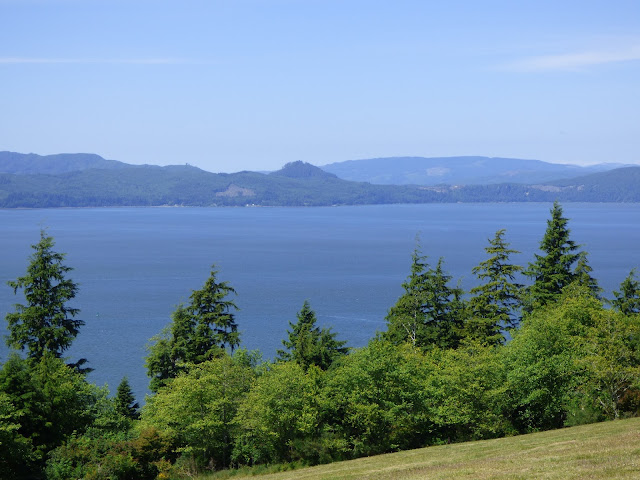Today we had our final guided tour - one that took us to the special points near the mouth of the Columbia River - places Lewis and Clark along with all those on the expedition completed their assigned task of reaching the Pacific Ocean in 1805.
They first landed on the Washington State side of the Columbia River thinking they had reached the ocean but discovered after searching the area on foot they had fallen short of that spot. Indians brought them some pounded fish but they really needed to find a place to settle for the winter that would also provide them with meat and fresh water.
So they moved to an area still on the Washington side searching for a place to settle - it is referred to as Camp Disappointment. Here they ended up taking a vote as to where they should settle (indians had told them of the availability of elk on the Oregon side).
They reached the Pacific Ocean on the Washington State side - hungry, cold, and wet and needing a home for the winter months.Before returning to the Oregon side to see where they finally settled for the winter, we visited a Cranberry experimental farm. This happens to be a very successful area for raising cranberries. (in fact, Ocean Spray use to have a big operation in this area) Each square is a different type of cranberry.
The little black "sticks" are sprinklers used to not only water if necessary but then in October at harvest time they are used to "flood" the plants to assist in picking. The bushes are shaken to release the berries and then a machine like a vacumn cleaner sucks them up
We then went back across the Astoria-Megler Bridge that connects the states of Washington and Oregon
and enjoyed a box lunch at the little Maritime Memorial Park under the bridge and along the water front. The bar of shallow waters (especially at low tide) makes the entry into the Columbia River from the Pacific Ocean especially treacherous. Storms can bring 40 foot waves. This then is a very dangerous area for those on ships and boats. Over 900 people have lost their lives trying to navigate this spot. This park is dedicated to them with a series of walls with their names on it including the son of our guide Rae Goforth.
Following lunch we visited Fort Clatsop, the reproduction of the fort where the Corps of Discovery ultimately ended up spending their winter before returning to St. Louis, MO. They needed a place on a hill but close to the water so they could leave their canoes nearby. They also needed it to be near a source of freshwater and there was a creek on the hillside behind it. They were in the woods and near herds of elk that they could kill not only for food but for the hides that were converted to two sets of clothing for each member of the group plus 11 sets of moccasins per member to be used on their return journey. The ocean water was collected to make salt for seasoning and for preserving meat for their travels as well.
Four of the eight rooms in the fort were set up to sleep 8 men eachOne was for Toussaint Charbonneau and his wife Sacagawea and their son John Baptiste.
Lewis and Clark shared another room and the remaining space was for storage and working in.
They had only eleven days without rain during the four months they were residing here so everything must have been perpetually damp. But they had a good relationship with the Clatsop Indians in the area and when they left they gave them the fort for their use.
We enjoyed a film about their relationship with the Clatsop Indians in the little Interpretive Center near the fort as well as viewing some of the displays including this statue of Lewis and Clark with a Clatsop Indian
There is a steep 600 foot hill in the center of town with the Astoria Column on top as well as gorgeous views of the town, the Pacific Ocean and Columbia River.
The column was built by a man interested in attracting people to the area. It has the history of the area painted around it but we could not see anything since it is covered in plastic while it is being repaired. Luckily Ken and I got to see it back in 2009 when we traveled through here after leaving Alaska.
This is how it looked in 2009




















No comments:
Post a Comment